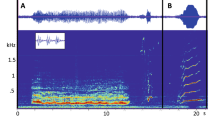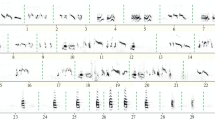Abstract
Blue-throated hummingbirds produce elaborate songs extending into the ultrasonic frequency range, up to 30 kHz. Ultrasonic song elements include harmonics and extensions of audible notes, non-harmonic components of audible syllables, and sounds produced at frequencies above 20 kHz without corresponding hearing range sound. To determine whether ultrasonic song elements function in intraspecific communication, we tested the hearing range of male and female blue-throated hummingbirds. We measured auditory thresholds for tone pips ranging from 1 kHz to 50 kHz using auditory brainstem responses. Neither male nor female blue-throated hummingbirds appear to be able to hear above 7 kHz. No auditory brainstem responses could be detected between 8 and 50 kHz at 90 dB. This high-frequency cutoff is well within the range reported for other species of birds. These results suggest that high-frequency song elements are not used in intraspecific communication. We propose that the restricted hummingbird hearing range may exemplify a phylogenetic constraint.





Similar content being viewed by others
References
Boettcher FA, Mills JH, Norton BL (1993) Age-related changes in auditory-evoked potentials of gerbils. 1. Response amplitudes. Hear Res 71:137–145
Borg E, Engstrom B (1983) Hearing thresholds in the rabbit—a behavioral and electrophysiological study. Acta Otolaryngol 95:19–26
Brittan-Powell EF, Dooling RJ, Gleich O (2002) Auditory brainstem responses in adult budgerigars (Melopsittacus undulatus). J Acoust Soc Am 112:999–1008
Carr CE (1992) Evolution of the central auditory system in reptiles and birds. In: Webster DB, Fay RR, Popper AN (eds) The evolutionary biology of hearing. Springer, Berlin Heidelberg New York, pp 511–544
Corwin JT, Bullock TH, Schweitzer J (1982) The auditory brain stem response in five vertebrate classes. Electroencephalogr Clin Neurophysiol 54:629–641
Dmitrieva LP, Gottlieb G (1992) Development of brainstem auditory pathway in mallard duck embryos and hatchlings. J Comp Physiol A 171:665–671
Dooling RJ (1980) Behavior and psychophysics of hearing in birds. In: Popper AN, Fay RR (eds) Comparative studies of hearing in vertebrates. Springer, Berlin Heidelberg New York, pp 261–288
Dooling RJ (1982) Auditory perception in birds. In: Kroodsma DE, Miller EH (eds) Ecology and evolution of acoustic communication in birds. Cornell University Press, Ithaca, New York, pp 95–130
Dooling RJ (1992) Hearing in birds. In: Webster DB, Fay RR, Popper AN (eds) The evolutionary biology of hearing. Springer, Berlin Heidelberg New York, pp 545–560
Dooling RJ, Saunders JC (1975) Hearing in the parakeet (Melopsittacus undulatus): absolute thresholds, critical ratios, frequency difference limens, and vocalizations. J Comp Physiol Psychol 88:1–20
Dooling RJ, Mulligan JA, Miller JD (1971) Auditory sensitivity and song spectrum of the common canary (Serinus canarius). J Acoust Soc Am 50:700–709
Esser KH, Daucher A (1996) Hearing in the FM-bat Phyllostomus discolor: a behavioral audiogram. J Comp Physiol A 178:779–785
Ficken MS, Rusch KM, Taylor SJ, Powers DR (2000) Blue-throated hummingbird song: a pinacle of nonoscine vocalizations. Auk 117:120–128
Ficken MS, Rusch KM, Taylor SJ, Powers DR (2002) Reproductive behavior and communication in blue-throated hummingbirds. Wilson Bull 114:197–209
Johnsgard PA (1983) The hummingbirds of North America, 2nd edn. Smithsonian Institute Press, Washington, DC
Konishi M (1971) Comparative neurophysiological studies of hearing and vocalizations in songbirds. Z Vergl Physiol 66:257–272
Kroodsma DE, Vielliard JME, Stiles FG (1996) Study of bird sounds in the neotropics: urgency and opportunity. In: Kroodsma DE, Miller EH (eds) Ecology and evolution of acoustic communication in birds. Cornell University Press, Ithaca, New York, pp 269–282
Mann DA, Higgs DM, Tavolga WN (2001) Ultrasound detection by clupeiform fishes. J Acoust Soc Am 109:3048–3054
Narins PM, Feng AS, Lin W, Schnitzler H-U, Denzinger A, Suthers RA, Xu C (2004) Old world frog and bird vocalizations contain prominent ultrasonic harmonics. J Acoust Soc Am 115:910–913
Neuweiler G, Bruns V, Shuller G (1980) Ears adapted for the detection of motion, or how echolocating bats have exploited the capacities of the mammalian auditory system. J Acoust Soc Am 68:741–753
Ornelas JF, González C, Uribe J (2002) Complex vocalizations and aerial displays of the amethyst-throated hummingbird (Lampornis amethystinus). Auk 119:1141–1149
Park TJ, Dooling RJ (1991) Sound localization in small birds: absolute localization in azimuth. J Comp Psychol 105:125–133
Plassman W, Brändle K (1992) A functional model of the peripheral auditory system in mammals and its evolutionary implications. In: Webster DB, Fay RR, Popper AN (eds) The evolutionary biology of hearing. Springer, Berlin Heidelberg New York, pp 637–654
Pye JD (1980) Echolocation signals and echoes in air. In: Busnel R-G, Fish JF (eds) Animal sonar systems. Plenum Press, New York, pp 309–353
Pytte CL, Rusch KM, Ficken MS (2003) Regulation of vocal amplitude by the blue-throated hummingbird, Lampornis clemenciae. Anim Behav 66:703–710
Sachs MB, Sinnott JM, Hienz RD (1978) Behavioral and physiological studies of hearing in birds. Fed Proc 37:2329–2335
Sales GD, Pye JD (1974) Ultrasonic communication by animals. Chapman and Hall, London
Schuchmann K-L (1999) Family trochilidae. In: Hoyo J del, Elliott A, Sargatal J (eds) Handbook of the birds of the world, vol 5. Lynx Edicions, Barcelona, Spain, pp 468–535
Stapells DR, Oates P (1997) Estimation of the pure-tone audiogram by the auditory brainstem response: a review. Audiol Neurootol 2:257–280
Suthers RA, Hector DH (1982) Mechanism for the production of echolocating clicks by the grey swiftlet, Collocalia spodiopygia. J Comp Physiol A 148:457–470
Suthers RA, Hector DH (1985) The physiology of vocalization by the echolocating oilbird, Steatornis caripensis. J Comp Physiol A 156:243–266
Tchernichovski O, Nottebohm F, Ho CE, Pesaran B, Mitra PP (2000) A procedure for an automated measurement of song similarity. Anim Behav 59:1167–1176
Wenstrup JJ (1984) Auditory sensitivity in the fish-catching bat, Noctilioleporinus. J Comp Physiol 155:91–101
Williamson S (2000) Blue-throated hummingbird (Lampornis clemenciae). In: Poole A, Gill F (eds) The birds of North America, no. 531. The Birds of North America, Philadelphia, PA
Woolley SMN, Rubel EW (1999) High-frequency auditory feedback is not required for adult song maintenance in Bengalese finches. J Neurosci 19:358–371
Acknowledgements
We thank the Southwestern Research Station for housing the hummingbirds. Elizabeth Sandlin provided the use of mist nets and training in hummingbird capture. All animal care and methods complied with the regulations of the Institutional Animal Care and Use Committees of the affiliated universities, the Arizona Game and Fish Department, the Connecticut Department of Environmental Protection—Wildlife Division, and the US Fish and Wildlife Service, as well as the Principles of Animal Care of the National Institutes of Health. This research was funded by NSF SGER 0077980.
Author information
Authors and Affiliations
Corresponding author
Rights and permissions
About this article
Cite this article
Pytte, C.L., Ficken, M.S. & Moiseff, A. Ultrasonic singing by the blue-throated hummingbird: a comparison between production and perception. J Comp Physiol A 190, 665–673 (2004). https://doi.org/10.1007/s00359-004-0525-4
Received:
Revised:
Accepted:
Published:
Issue Date:
DOI: https://doi.org/10.1007/s00359-004-0525-4




